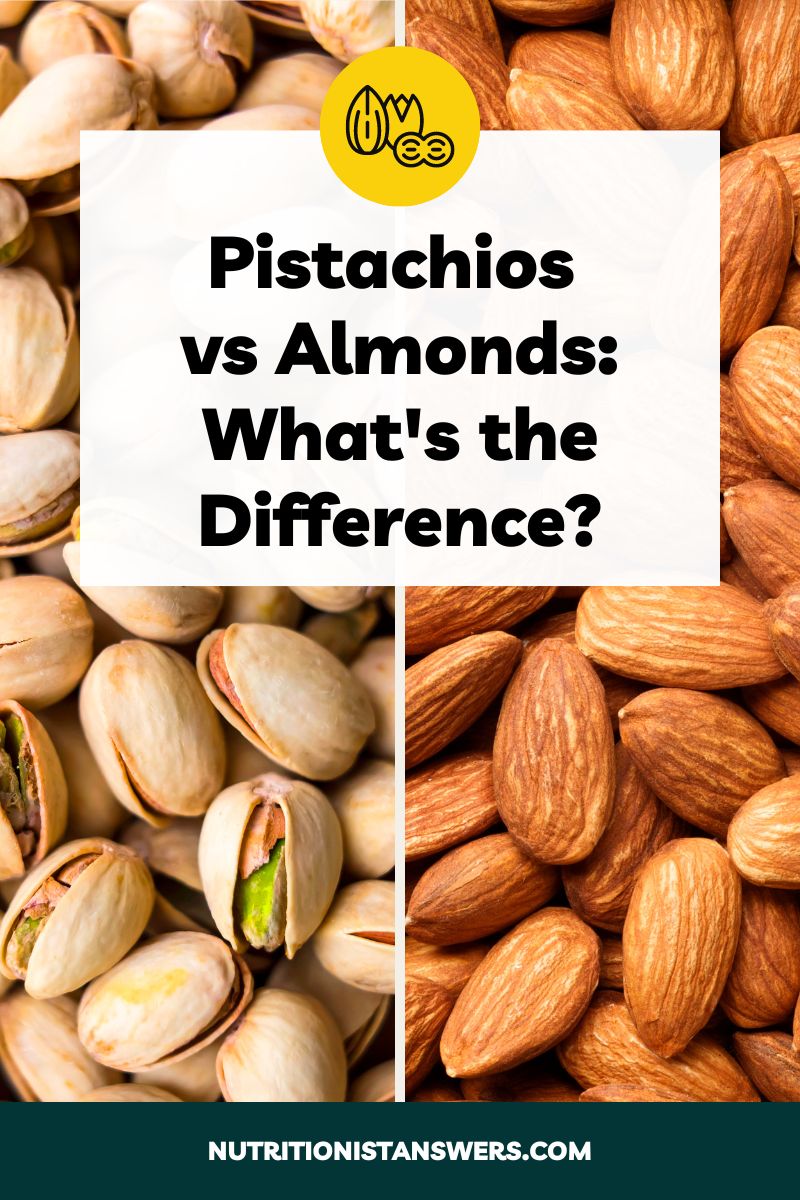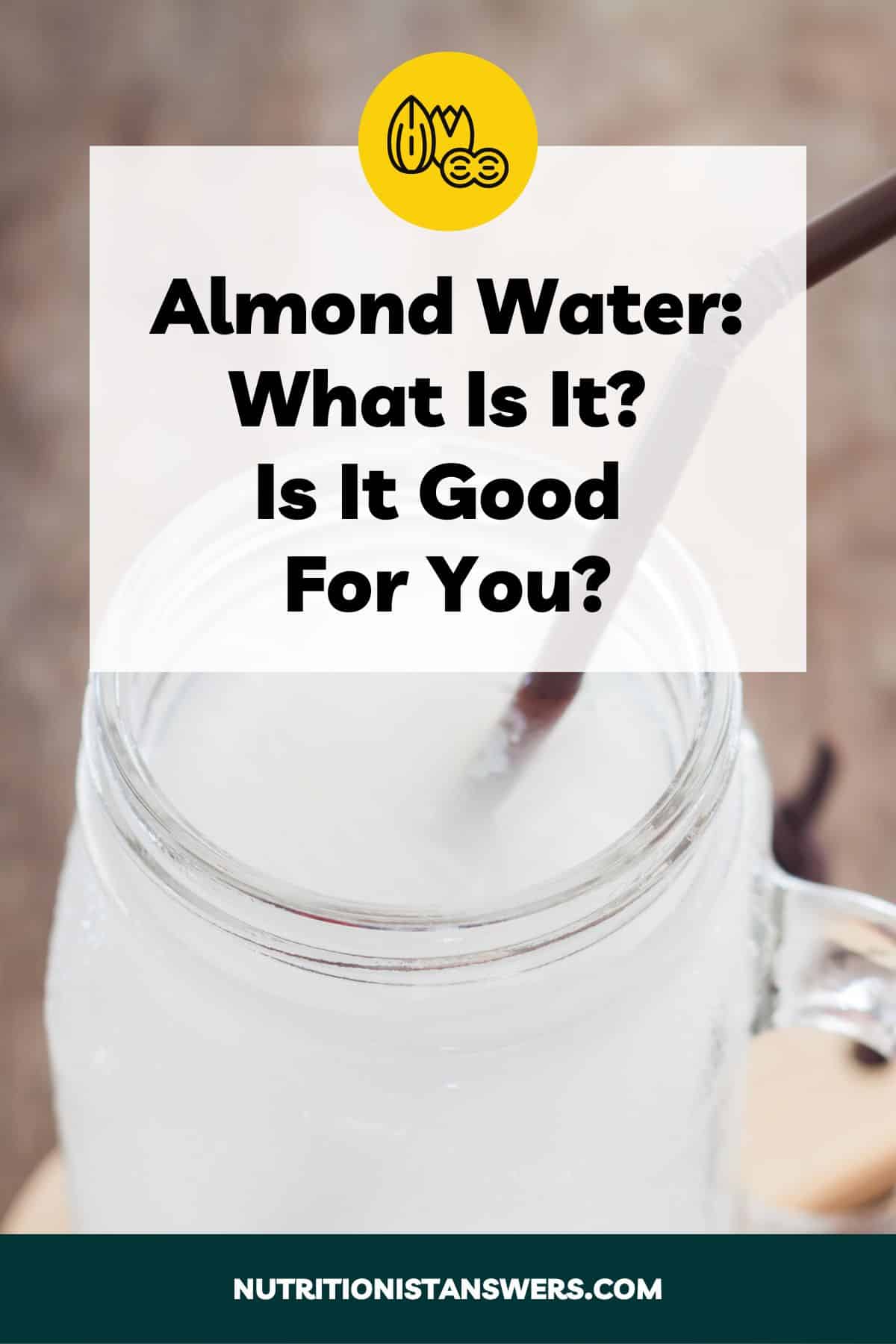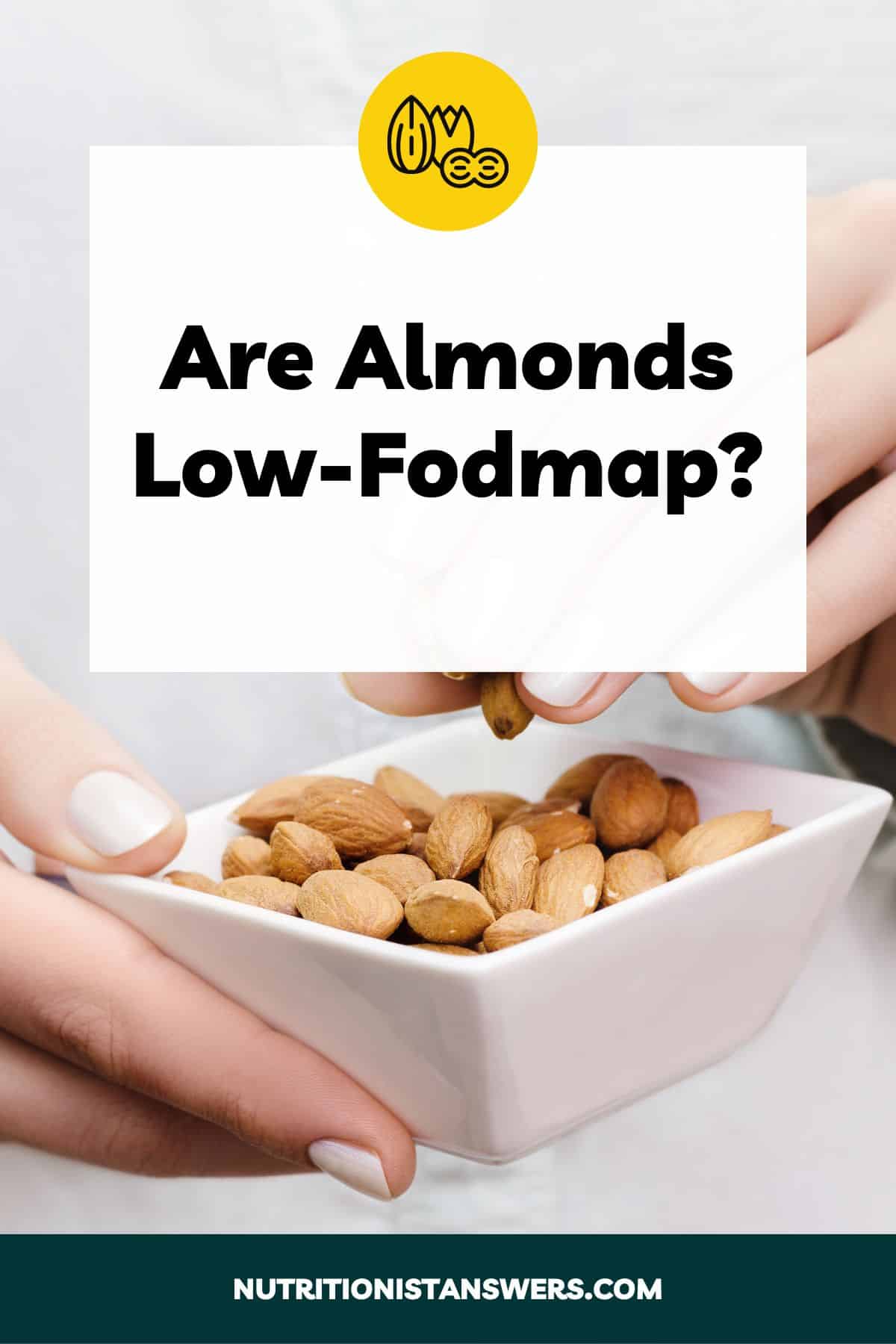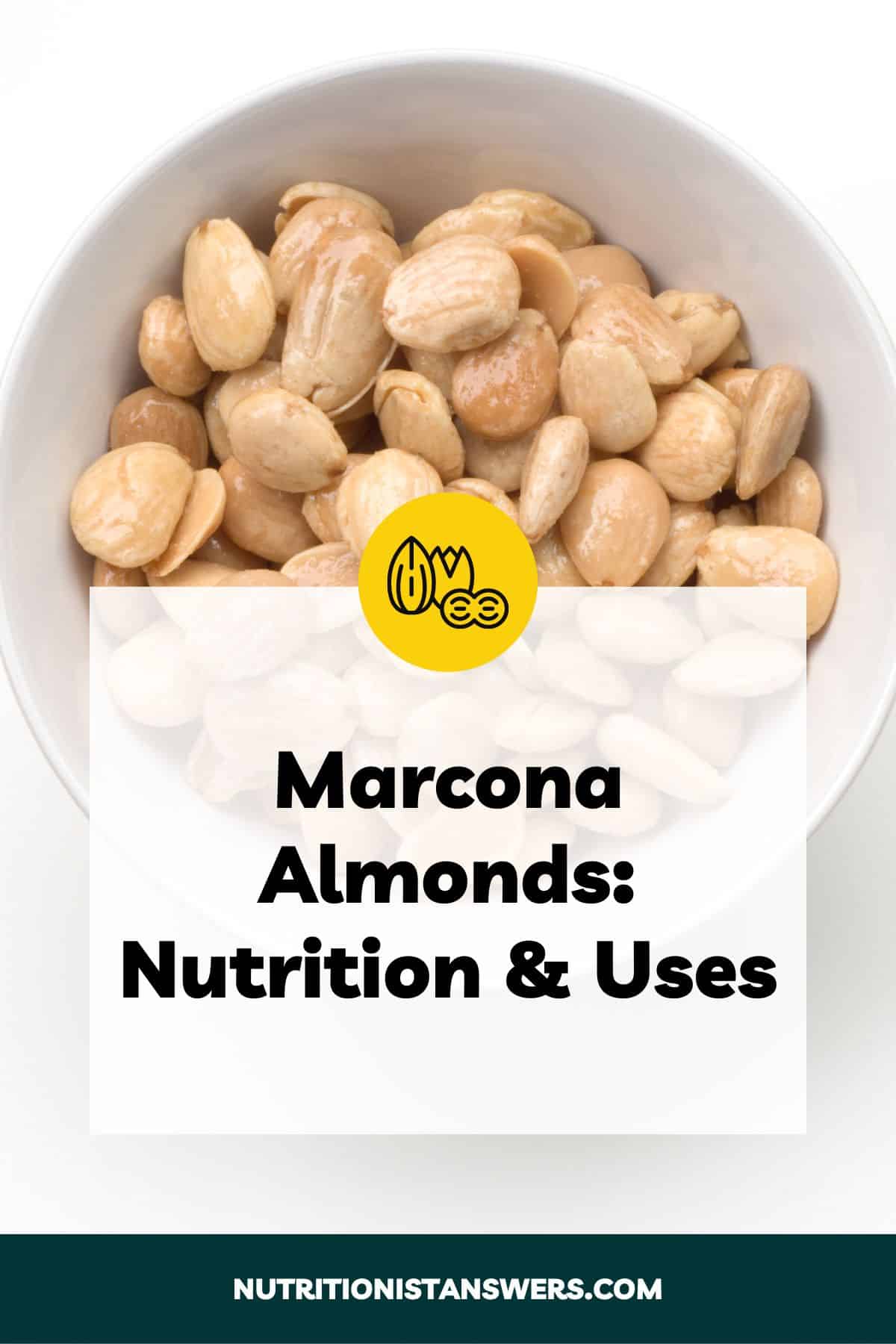Pistachios and almonds rank among the most popular tree nuts in the world. From snacking to baking, these two nuts add a crunchy texture and delicious flavor to many dishes.
Both are delicious and packed with healthy fats, fiber, B vitamins, and minerals. However, there are some notable differences to consider when choosing between the two.
In this article, we’ll explore the similarities and differences between pistachios and almonds, in terms of nutrition, taste, available forms, prices, and uses.
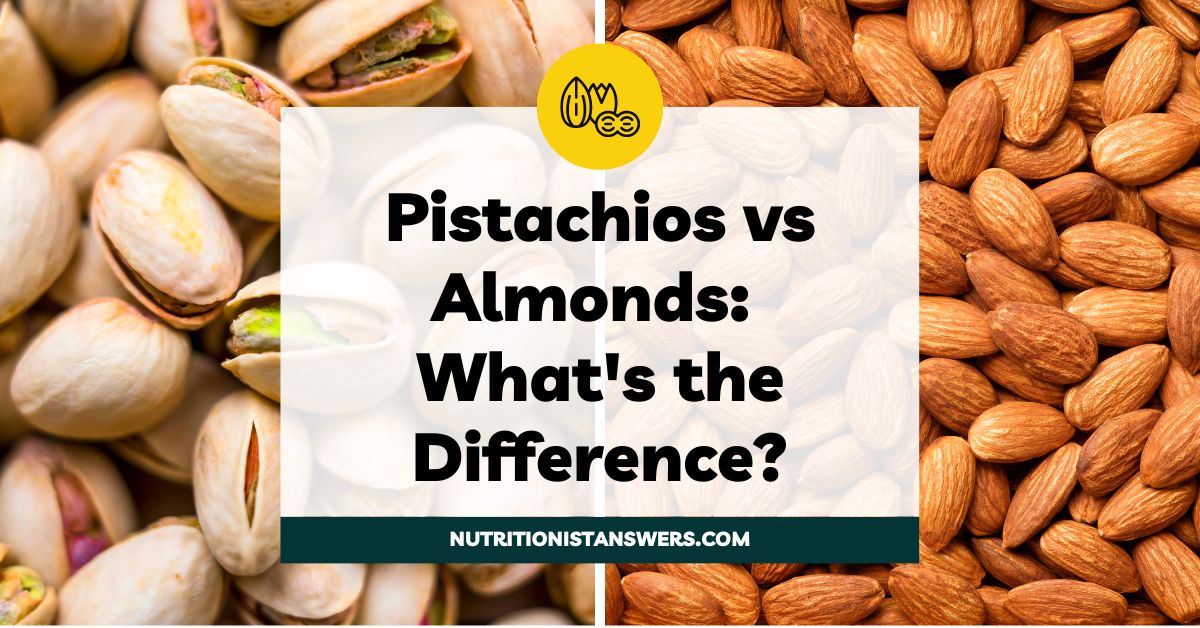
Please note that this article contains affiliate links. If you click one of these links and make a purchase, we may earn a commission. As an Amazon Associate, we earn from qualifying purchases.
What are pistachios?
Pistachios (Pistacia vera) are a type of tree nut that originated in the Middle East and belong to the same family as cashews, mangos, and sumac (1).
They are small, oval-shaped nuts with hard, beige shells that naturally split open as they mature. Inside, you’ll find a greenish-yellow kernel, often accompanied by a thin, purple-hued skin.
Pistachios offer a rich, nutty and somewhat earthy flavor with underlying woody notes. They have a soft and smooth texture that is only slightly crunchy.
You can find pistachios, either in-shell or shelled, in the snack aisle or bulk foods section of most supermarkets, health food markets, and online grocery retailers.
Pistachios can be enjoyed on their own as a snack or used to add crunch and flavor to salads, desserts, and main courses. They’re also often processed into pistachio butter, flour, or milk.
What are almonds?
Almonds, a type of tree nut, are produced by the almond tree (Prunus dulcis), which is native to Central Asia but now grows throughout the world (2).
They are encased in a hard, teardrop-shaped shell that needs to be cracked open to reveal the edible, creamy white kernel enveloped by a thin, brown skin.
Offering a crunchy texture, almonds have a subtle, nutty flavor with a slight sweetness and a hint of bitterness.
You can find almonds in the baking section, snack aisle, or the bulk foods section of most supermarkets and health food stores, as well as online.
With incredible versatility, almonds can be enjoyed as a snack, added to salads, used as a topping on baked goods, or transformed into almond milk or butter.
Pistachios vs almonds
Pistachios have a rich, nutty flavor with a slight sweetness and a buttery texture, while almonds have a more delicate, mildly nutty taste with a hint of bitterness and a more satisfying crunch.
Nutritionally, almonds and pistachios are very similar. The main differences are that pistachios contain more carbohydrates, and almonds are slightly higher in fat and calories.
Both almonds and pistachios are rich sources of minerals and B vitamins. Pistachios provide more thiamin, vitamin B6, and copper, whereas almonds are higher in riboflavin, manganese, and vitamin E.
Here’s a more detailed review of how they compare in flavor, nutrition, available forms, prices, and recommended uses:
Flavor comparison
Pistachios have a rich, nutty and slightly sweet flavor with woody undertones, while almonds offer a more subtle, mildly nutty taste with a hint of bitterness.
In terms of texture, pistachios are somewhat softer and often described as having a “buttery” feel, whereas almonds are harder and provide a more robust crunch.
Pistachios pair well with bright, citrusy flavors, as well as rich chocolate and savory spices. Almonds, with their versatile flavor profile, can harmonize with virtually any ingredient — from sweet elements like honey and vanilla to the bold savory tastes of rosemary and garlic.
Nutrition comparison
Here’s a side-by-side comparison of the calorie and macronutrient content of pistachios and almonds, based on a 1-ounce (28-gram) serving size (3, 4):
| Nutrient | Pistachios, unroasted (28g) | Almonds, unroasted (28g) |
| Calories | 159 | 164 |
| Protein | 6 grams | 6 grams |
| Fat | 13 grams | 14 grams |
| Saturated fat | 2 grams | 1 gram |
| Monounsaturated fat | 7 grams | 9 grams |
| Polyunsaturated fat | 4 grams | 4 grams |
| Carbohydrates | 8 grams | 6 grams |
| Fiber | 3 grams | 3.5 grams |
Calories
Pistachios have slightly fewer calories than almonds.
A 1-ounce (28-gram) serving of almonds provides 164 calories, while the same serving of pistachios offers 159 calories.
Protein
Almonds and pistachios both provide about 6 grams of fat per serving.
Fat
Both pistachios and almonds are high in fat, but almonds provide one gram more of fat than pistachios.
A 1-ounce (28-gram) serving of almonds contains 14 grams of fat, while an equal serving of pistachios includes 13 grams of fat.
Pistachios are higher in saturated fat, while almonds are mostly made up of heart-healthy monounsaturated fats.
Carbohydrates
Pistachios are higher in carbohydrates than almonds and many other nuts. A 1-ounce serving of pistachios provides 8 grams of carbohydrates and 3 grams of fiber.
With 6 grams per serving, almonds are 25% lower in carbohydrates than pistachios. If you’re looking for a lower carb snack option, almonds are the better nut choice.
Vitamins and minerals
Here’s an overview of the vitamin and mineral content of pistachios and almonds, based on a 1-ounce (28-gram) serving (3, 4):
| Nutrient | Pistachios, unroasted (28g) | Almonds, unroasted (28g) |
| Vitamin A | 7 mcg RAE (1% DV) | 0 mcg RAE (0% DV) |
| Vitamin B1 (Thiamin) | 0.2 mg (17% DV) | 0.06 mg (5% DV) |
| Vitamin B2 (Riboflavin) | 0.05 mg (4% DV) | 0.3 mg (23% DV) |
| Vitamin B3 (Niacin) | 0.4 mg (3% DV) | 1 mg (6% DV) |
| Vitamin B5 (Pantothenic acid) | 0.1 mg (2% DV) | 0.1 mg (2% DV) |
| Vitamin B6 (Pyridoxine) | 0.5 mg (29% DV) | 0.04 mg (2% DV) |
| Vitamin B9 (Folate) | 15 mcg (4% DV) | 13 mcg (3% DV) |
| Vitamin B12 (Cobalamin) | 0 mcg (0% DV) | 0 mcg (0% DV) |
| Vitamin C | 2 mg (2% DV) | 0 mg (0% DV) |
| Vitamin D | 0 mcg (0% DV) | 0 mcg (0% DV) |
| Vitamin E | 0.8 mg (5% DV) | 7 mg (47% DV) |
| Vitamin K | Not listed | 0 mcg (0% DV) |
| Choline | Not listed | 15 mg (3% DV) |
| Sodium | 0.3 mg (<1% DV) | 0.3 mg (<1% DV) |
| Potassium | 289 mg (6% DV) | 208 mg (4% DV) |
| Calcium | 30 mg (2% DV) | 76 mg (6% DV) |
| Phosphorus | 139 mg (11% DV) | 136 mg (11% DV) |
| Magnesium | 45 mg (11% DV) | 77 mg (18% DV) |
| Iron | 1.1 mg (6% DV) | 1.1 mg (6% DV) |
| Zinc | 0.6 mg (5% DV) | 0.9 mg (8% DV) |
| Copper | 0.37 mg (41% DV) | 0.29 mg (32% DV) |
| Manganese | 0.3 mg (13% DV) | 0.6 mg (26% DV) |
| Selenium | 2 mcg (4% DV) | 1 mcg (2% DV) |
Pistachios are much higher in thiamin, vitamin B6, and copper than almonds.
Almonds, on the other hand, are significantly higher in riboflavin, magnesium, and manganese than pistachios. They also offer close to 50% of the DV for vitamin E.
Special Diets
If you’re following a special diet, you may be wondering whether pistachios or almonds are a better choice for you.
Dairy free diet
Both pistachios and almonds are naturally dairy-free.
Gluten free diet
Both almonds and pistachios are naturally gluten-free and can be consumed on a gluten-free diet.
Ketogenic diet
For people following a keto diet, almonds are a better choice than pistachios.
Almonds have 6 grams of carbs and 3.5 grams of fiber per 1-ounce (28-gram) serving, while an equal portion of pistachios contains 8 grams of carbs and 3 grams of fiber.
Pistachios can still be enjoyed on a keto diet, but keep in mind that a single serving (1 ounce) can easily take up 20-40% of your total daily carb allowance.
Low fat diet
Pistachios and almonds are very high in fat and may need to be limited on a low-fat diet.
Generally, low-fat diets limit fat to 30% or less of total daily calorie intake (5). On a 2,000-calorie low-fat diet, a single serving of pistachios or almonds would take up about one-third of your daily fat allowance.
Low-FODMAP diet
Both pistachios and almonds are high-FODMAP, according to the Monash University FODMAP Diet app.
A 1-ounce serving (about 20 nuts) of almonds is high in galactans. Almond butter and almond flour are also high in galactans in servings larger than 1 tablespoon and ⅓ cup, respectively.
Almonds can only be consumed on the low-FODMAP diet in portions of 10 almonds or less (roughly half the typical serving size for almonds).
Pistachios are high in both galactans and fructans when consumed in a typical serving of 1 ounce (around 30 nuts).
Smaller portions of about 15 pistachios (½ ounce) are low in fructans but still high in galactans.
Low sodium diet
Almonds and pistachios are both naturally low in sodium. However, many nuts are salted and usually contain around 80 mg (or more) of sodium per serving.
If you’re following a low-sodium diet, which limits sodium to less than 2300 mg, you may want to choose unsalted or lightly salted nuts instead (5).
Vegetarian diet
Both pistachios and almonds are plant-based and can be eaten on a vegetarian diet.
Vegan diet
Almonds and pistachios are both vegan, since they come from plants.
Available forms
1. Whole (pistachios and almonds)
Almonds are typically sold whole with their shells removed, while pistachios are sold either shelled or in-shell.
You can find them easily at most supermarkets and health food stores, in the baking aisle, bulk foods section, or snack aisle. They can also be purchased in bulk online from Nuts.com.
Buying whole nuts and chopping them at home is usually less expensive than buying pre-chopped or sliced nuts.
2. Pre-cut (almonds only)
Pre-cut nuts are a hassle-free option that can be eaten or used in recipes without any preparation.
Almonds are available sliced or slivered (peeled and cut into tiny sticks) and can be found in the baking aisle or bulk foods section of the grocery store.
Pre-cut pistachios are less common because they are softer and easier to chop on your own at home. To save time, you can also pulse them in a food processor instead of using a knife.
3. Flour (pistachios and almonds)
Nut flours made from almonds or pistachios can be used to replace wheat flour in gluten-free baked goods, breaded meats, and more.
Almond flour is usually located in the baking aisle or bulk foods section of most supermarkets, and can also be purchased online.
PIstachio flour is less common than almond flour but is sometimes available online. The Pistachio Factory is a brand that sells pistachio flour and other pistachio-based products on Amazon.
4. Butters (pistachios and almonds)
Almond butter is a popular alternative to peanut butter and can be found at most grocery stores, as well as online.
Pistachio butter is relatively rare, but can sometimes be found at health food stores and online. The Pistachio Factory has a pistachio butter product available on Amazon.
Another option is to make your own pistachio butter using a food processor or high-powered blender.
5. Oil (pistachios and almonds)
Roasted pistachio oil is sold by brands like La Tourangelle and can be used in cooking.
It has a rich, sweet and nutty flavor that can elevate salad dressings, roasted vegetables, pasta dishes, and even desserts.
Almond oil (also called sweet almond oil) is a cooking oil made by pressing almonds. It is not the same as bitter almond oil, an essential oil extracted from bitter almonds (6).
Sweet almond oil has a mild, nutty flavor and a high smoke point of 221°C (430°F) (7). It’s great for baking, roasting, and frying, as well as adding flavor to salads and other side dishes.
6. Milks (pistachios and almonds)
Almond milk is a popular non-dairy milk product that can be found in both the refrigerated and shelf-stable sections of most grocery stores.
Pistachio milk is a little more expensive and harder to find. Tache and Three Trees are two pistachio milk brands that are sold at some health food stores, and Elmhurst offers a barista edition pistachio milk on Amazon.
Cost
Almonds are 2-3 times cheaper than pistachios.
A 1-pound (16-ounce) package of shelled pistachios costs $13-16, while almonds cost $5-7 for the same amount.
To get the most bang for your buck, you can buy nuts in bulk and store them in the freezer — keeping them cool will help keep them from going rancid.
Recommended uses
Pistachios and almonds can be used in many of the same ways.
1. Trail mixes and snacks
Pistachios and almonds both make excellent additions to trail mixes and snacks.
Pistachios, with their distinctive green hue and slightly sweet flavor, add a unique touch to trail mix and pair exceptionally well with dried fruits like cranberries or apricots.
Almonds, due to their neutral taste, can easily blend with a variety of ingredients, making them an excellent choice for snack mixes that include elements like dark chocolate, raisins, or other nuts.
Additionally, both nuts can be consumed on their own as a healthy, protein-packed snack. Whether you’re preparing for a long hike or just need a midday pick-me-up, these nuts are a nutritious and tasty choice.
2. Baked goods and desserts
In the world of baking, pistachios and almonds offer different flavors and textures that can enhance various desserts.
Pistachios, with their unique color and flavor, can be incorporated into desserts like pistachio muffins or a pistachio-crusted cheesecake for a visually striking and delicious result.
Almonds, on the other hand, are often used in traditional treats like almond biscotti, amaretti cookies, and almond frangipane tarts.
Ground into almond or pistachio flour, these nuts also provide a gluten-free alternative for baking. From cakes to cookies, these nuts can add a delightful crunch and rich flavor.
3. Salads and side dishes
Salads and side dishes can greatly benefit from the addition of pistachios and almonds.
Roasted pistachios can be sprinkled over a beet and goat cheese salad for a crunchy contrast, or mixed into a quinoa salad with pomegranate seeds for a burst of flavor.
Almonds can be slivered and tossed into a simple green salad or added to green beans with a tangy lemon vinaigrette. They can also be mixed into a couscous dish with dried fruit and herbs, adding a satisfying crunch and enhancing the overall flavor profile.
These nuts not only add texture but also boost the nutritional value of these dishes.
4. Breaded meats and fish
For breaded meats and fish, almonds and pistachios can offer a delicious and nutritious twist to traditional breadcrumbs.
Almond-crusted chicken or fish can provide a crunchy exterior with a subtle nutty flavor that pairs wonderfully with a squeeze of fresh lemon and fresh herbs.
On the other hand, finely chopped pistachios can create an attractive green crust on lamb, pork, or salmon, offering a rich, slightly sweet flavor.
Keep in mind that nuts can burn quickly, so you’ll need to adjust the cooking time accordingly. Aim for a golden brown crust that is crispy on the outside and cooked through on the inside.
Final thoughts
Pistachios are rich, nutty, and slightly sweet with a woody undertone and a soft, buttery texture, while almonds have a more delicate, mildly nutty flavor and a more satisfying crunch.
Nutritionally, pistachios are higher in carbohydrates and certain vitamins and minerals, including thiamin and copper. Almonds are higher in fat and calories, as well as riboflavin, manganese, and vitamin E.
Almonds and pistachios are available in many different forms, including whole, flour, nut butter, and oil. Pistachios are 2-3 times more expensive than almonds.
Both nuts can be used in many of the same ways, such as trail mixes, baked goods and desserts, salads, and breaded meats.
Interested in seeing how almonds compare to other nuts? Check out our in-depth comparisons of almonds vs pecans, almonds vs cashews, almonds vs Brazil nuts, almonds vs peanuts, and almonds vs walnuts.
Amy Richter is a Registered Dietitian Nutritionist based in Missouri. She is an experienced nutrition writer and medical advisor for Healthline and Medical News Today. Amy is passionate about all things food-related and enjoys translating complex science into easy-to-understand articles.

